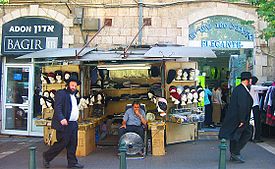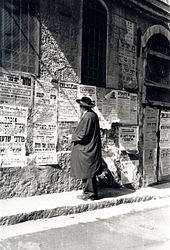- Mea Shearim
-
Mea Shearim (Hebrew: מאה שערים, lit. "hundredfold" or "hundred gates") is one of the oldest Jewish neighborhoods in Jerusalem, Israel. It is populated mainly by Haredi Jews and was built by the original settlers of the Yishuv haYashan.
Contents
Name
The name Mea Shearim is derived from a verse in the weekly Torah portion which was read the week the settlement was founded: "Isaac sowed in that land, and in that year he reaped a hundredfold (מאה שערים, mea shearim); God had blessed him" (Genesis 26:12). According to a tradition, the community originally had 100 gates, another meaning of mea shearim.[1]
History
Mea Shearim was established in 1874 as the second settlement outside the walls of the Old City by a building society of 100 shareholders.[2] Pooling their resources, the society members purchased a tract of land outside the Old City, which was severely overcrowded and plagued by poor sanitation, and built a new neighborhood with the goal of improving their standards of living.
Conrad Schick, a German Christian architect and missionary, drew up a plan for Mea Shearim in 1846. Joseph Rivlin, one of the heads of the Jewish community in Jerusalem, and a Christian Arab from Bethlehem were the contractors. The work was carried out by both Jewish and non-Jewish workers.[3]
The quarter was surrounded by a wall, with gates that were locked every evening. By October 1880, 100 apartments were ready for occupancy and a lottery was held to assign them to families. By the turn of the century, there were 300 houses, a flour mill and a bakery. Conrad Schick planned for open green space in each courtyard, but cowsheds were built instead. Mea Shearim was the first quarter in Jerusalem to have street lights.[3]
Haredi lifestyle
Today, Mea Shearim remains an Old World enclave in the heart of Jerusalem.[3] With its overwhelmingly Haredi population, the streets retain the flavor of an East European shtetl.[1] Life revolves around strict adherence to Jewish law, prayer, and the study of Jewish texts. Traditions in dress may include black frock coats and black or fur-trimmed hats for men (although there are many other clothing styles, depending on the religious sub-group to which they belong), and long-sleeved, modest clothing for women. In some groups, the women wear thick black stockings all year long, including summer. Married women wear a variety of headcoverings, from wigs to headscarves. The men have beards and some grow long sidecurls, called payot.
Hasidic groups with a large number of followers in Mea Shearim include Breslov, Slonim, and Toldos Aharon. The Karlin-Stolin dynasty has its center here.[4] Mea Shearim is also the stronghold of the 'anti-Zionist' Neturei Karta movement. The Edah HaChareidis, which supervises kashrut certification and runs a Jewish religious court, has its headquarters in Mea Shearim.
Neighborhood regulations
"Modesty" posters in Hebrew and English are hung at every entrance to Mea Shearim. When visiting the neighborhood, women and girls are asked to dress modestly (knee-length skirts or longer, no plunging necklines or midriff tops, no sleeveless blouses or bare shoulders) and tourists are requested not to arrive in large, conspicuous groups. During the Shabbat (from sunset Friday until it is completely dark on Saturday night), visitors should refrain from smoking, photography, driving or use of mobile phones. When entering synagogues, men should cover their heads.[4]
See also
References
- ^ a b Eisenberg, Ronald L. (2006). The Streets of Jerusalem: Who, what, why. Devora Publishing. p. 250. ISBN 1932687548. http://books.google.com/books?id=yqXXD_74yAEC&printsec=frontcover&dq=ronald+eisenberg&hl=en#v=onepage&q=me'a%20she'&f=false.
- ^ "About Meah Shearim". Illustrated Israel. http://www.eyecomvisual.com/illusisrael/01/Meah-Shearim.htm.
- ^ a b c Eylon, Lili (2011). "Jerusalem: Architecture in the late Ottoman Period". Jewish Virtual Library. http://www.jewishvirtuallibrary.org/jsource/Archaeology/jerott.html. Retrieved 28 August 2011.
- ^ a b Sapir-Witz, Karmit (17 December 2006). "A step away, another world". Ynetnews. http://www.ynet.co.il/english/articles/0,7340,L-3340111,00.html. Retrieved 28 August 2011.
Further reading
- Halper, Jeff Between Redemption and Revival: The Jewish Yishuv of Jerusalem in the Nineteenth Century (Westview Press, 1991). ISBN 0-8133-7855-9
External links
Coordinates: 31°47′13″N 35°13′20″E / 31.78694°N 35.22222°E
Neighborhoods of Jerusalem Old City East Jerusalem American Colony • Al Bustan • Al-Issawiya • At-Tur • Bab a-Zahara • Beit Hanina • Jabel Mukaber • Ma'ale ha-Zeitim • Nachalat Shimon • Nof Zion • Ras al-Amud • Sheikh Jarrah • Shimon HaTzadik • Shuafat • Silwan • Sur Baher • Umm Tuba • Wadi al-JozHaredi neighborhoods Batei Munkatch • Batei Ungarin • Beit Yisrael • Ezrat Torah • Geula • Givat Shaul • Har Nof • Kerem Avraham • Kiryat Belz • Kiryat Mattersdorf • Kiryat Sanz • Kiryat Shomrei Emunim • Machanayim • Mea Shearim • Mekor Baruch • Nachalat Ya'akov • Ramat Shlomo • Ramot Polin • Sanhedria • Sanhedria Murhevet • Sha'arei Hesed • Shmuel HaNavi • Tel Arza • Unsdorf • Zikhron MosheCentral Neighborhoods Batei Nissan Bak • Beit David • Beit Ya'akov • Bukharan neighborhood • Even Yisrael • Ezrat Yisrael • Givat Ram • Katamon • Kiryat Shmuel • Kiryat Wolfson • Mahane Israel • Mahane Yehuda • Merhavia • Mishkenot Sha'ananim • Musrara • Nachalat Achim • Nachlaot • Nayot • Neve Sha'anan • Ohel Shlomo • Rehavia • Yemin MosheNorthern Neighborhoods French Hill • Givat HaMivtar • Ma'alot Dafna • Neve Yaakov • Pisgat Ze'ev • Ramat Eshkol • Ramot • Ramot PolinSouthern Neighborhoods Abu Tor • Baka • Beit Safafa • East Talpiot • The German Colony • Gilo • Givat HaMatos • Greek colony • Har Homa • Mekor Chaim • Ramat Rachel • TalpiotWestern Neighborhoods Bayit VeGan • Beit HaKerem • Givat Massuah • Givat Mordechai • Givat Oranim • Har Hotzvim • Ir Ganim • Katamonim • Kiryat HaYovel • Kiryat Menachem • Kiryat Moshe • Malha • Motza • Pat • Ramat Beit HaKerem • Ramat Denya • Ramat Sharett • Romema • Yefeh NofHistoric Neighborhoods See also: Ring NeighborhoodsCategories:- Neighbourhoods of Jerusalem
- Orthodox Jewish communities in Jerusalem
- Jews and Judaism in Palestine
Wikimedia Foundation. 2010.





